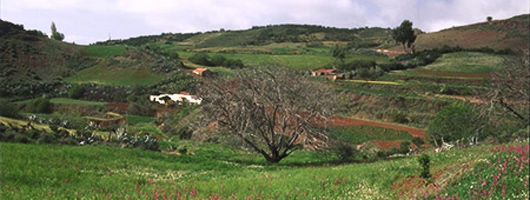Gáldar holds the main fiesta of the town in honour of its patron saint on July 25th, the Fiesta de Santiago de los Caballeros. The festivities organised from July 1st to August 5th include the election of la Guayarmina and her court of Tenesoyas; the procession with an offering to the Patron Saint in which the different districts of the municipality take part along with floats from other municipalities of the island, with the offering of typical products of Gran Canaria to Santiago Apóstol (Saint James the Apostle); the floats, the "flower battle", and the fireworks in the centre of Gáldar; and the traditional blessing of vehicles in the main church of Santiago on July 27th for the fiesta de San Cristóbal.

Amongst other processions, the ones held in Gáldar are outstanding. During May there is a procession in honour of Saint Isidro, and every year on the 5th January the procession of the Three Wise Men is held. Gáldar, one of the few towns to maintain the tradition over the years, decks itself out to relive this procession which is full of beautiful memories.
Another fiesta of interest celebrated in Gáldar is Carnival held during February.
The former town of Agáldar, the seat of several social and political institutions, was the main settlement of the territory of the island before annexation by the Crown of Castilla. Because the leaders were recognised as Kings of the Canary Islands by the Castilian monarchs, Agáldar was tacitly acknowledged as the Pre-Hispanic capital and as the birthplace and the court of the governing dynasty of the island.

The creation of the parish of Santiago de Gáldar, at the end of the fifteenth century, made the municipality one of the main centres in the beginnings of Christianity in the Canary Islands, and consolidated the continuity of the town as the political and administrative centre of the northwest section of Gran Canaria, from which the territorial units of Guía, Agaete and Artenara would later segregate.
Gáldar, which retained many of the traces of its noble past until the end of the eighteenth century, underwent a period of economic and social splendour at that time which finally gave way to a period of urban remodelling lasting nearly a century, to which a good deal of the present day appearance of the city is attributable.

The prestige of the Town of Gáldar in the nineteenth century can be seen in several events: the fact that it was appointed the Provisional Seat of the Court in 1812 and the centre of the administrative district in 1837; the emotive establishment of the Provincial Government Commission in 1843 and the Royal Theatre Foundation in 1847, the creation of the Navy Adjutancy in 1859, and in the obtaining of the title of City in 1894.
The twentieth century, after the first decades of great trading activity and the trauma of the Civil War, later brought intensive economic and demographic recovery, concluding with the formation of a rich and extremely varied historic centre where archaeological parks coexist with public and private buildings in a variety of styles from the seventeenth century to the present day.
The municipality of Gáldar is in the northwest corner of the island of Gran Canaria, in the area known as the "Northwest region", and is 27 kilometres from the capital of the island.

It has a surface area of 61.58 square kilometres, and the upper vertex of the municipality, which reaches as far as the centre of the island right from the north coast, is at an altitude of around 1700 metres. The perimeter of the municipality is like an irregular triangle with a very sharp apex.
Gáldar is bordered in the North by the Atlantic Ocean, and in the South by the municipality of Artenara; in the East it is bordered by Santa María de Guía and Moya, and in the West by Agaete.
In the high regions of this northern municipality with rugged relief, the morphology is quite varied, with the formations of el Montañón Negro, la Caldera de los Pinos de Gáldar and el Barranco de Fagagesto which resulted from volcanic eruptions.
The geographical and historical characteristics of Gáldar mean that the activity of this municipality is primarily agricultural, with the banana being the main crop. In fact, this is the municipality which produces the most bananas in Gran Canaria.
Other traditional crops are the tomato and the famous Gáldar onions, as well as the crops found in the midlands, such as potatoesand corn.
Livestock raising is also an important activity in the life of the municipality, and we can see how Viera y Clavijo guaranteed the excellent quality and fame of its sheep milk cheeses and those known as "flower cheeses".